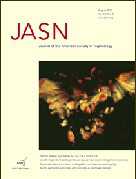PNAS:恢复捐献血液的一氧化氮水平可能减少输血的有害效应
2013-06-26 EurekAlert!中文 EurekAlert!中文
一项研究发现,对储存的血液的一种处理方式导致了动物在输血后向组织供氧能力的改善,而且有朝一日可能帮助减少与人类红细胞输血有关的不良心脏事件、肾衰竭以及死亡的风险。 在储存期间,红细胞迅速失去一氧化氮——这是血红蛋白携带的一种化学信使,以扩张血管的S-亚硝基硫醇的形式存在——因此也就削弱了细胞向组织供氧的能力。Jonathan Stamler及其同事研究了在输血前恢复红细胞的S-亚硝基血红蛋白(S
一项研究发现,对储存的血液的一种处理方式导致了动物在输血后向组织供氧能力的改善,而且有朝一日可能帮助减少与人类红细胞输血有关的不良心脏事件、肾衰竭以及死亡的风险。
在储存期间,红细胞迅速失去一氧化氮——这是血红蛋白携带的一种化学信使,以扩张血管的S-亚硝基硫醇的形式存在——因此也就削弱了细胞向组织供氧的能力。Jonathan Stamler及其同事研究了在输血前恢复红细胞的S-亚硝基血红蛋白(SNO-Hb)的水平——这个过程称为重新亚硝基化(renitrosylation)——是否能改善组织血流以及氧输送。
这组作者发现,输送红细胞缺少S-亚硝基血红蛋白(SNO-Hb)的血液能减少小鼠骨骼肌的氧浓度,而输送重新亚硝基化(renitrosylation)红细胞的血液维持了正常的氧浓度。此外,这组作者在贫血的大鼠或羊身上发现,与输了缺乏S-亚硝基血红蛋白(SNO-Hb)的血液的动物相比,获得重新亚硝基化(renitrosylation)红细胞的动物的血流、组织氧合作用以及肾功能都有所改善。这组作者说,这些发现提示储存的血液的重新亚硝基化(renitrosylation)可能是一种有前景的策略,用于改善输血后对组织的供氧,并且减少与输血相关的发病率和死亡率。

S-nitrosylation therapy to improve oxygen delivery of banked blood
Abstract
From the perspectives of disease transmission and sterility maintenance, the world’s blood supplies are generally safe. However, in multiple clinical settings, red blood cell (RBC) transfusions are associated with adverse cardiovascular events and multiorgan injury. Because ∼85 million units of blood are administered worldwide each year, transfusion-related morbidity and mortality is a major public health concern. Blood undergoes multiple biochemical changes during storage, but the relevance of these changes to unfavorable outcomes is unclear. Banked blood shows reduced levels of S-nitrosohemoglobin (SNO-Hb), which in turn impairs the ability of stored RBCs to effect hypoxic vasodilation. We therefore reasoned that transfusion of SNO-Hb–deficient blood may exacerbate, rather than correct, impairments in tissue oxygenation, and that restoration of SNO-Hb levels would improve transfusion efficacy. Notably in mice, administration of banked RBCs decreased skeletal muscle pO2, but infusion of renitrosylated cells maintained tissue oxygenation. In rats, hemorrhage-induced reductions in muscle pO2 were corrected by SNO-Hb–repleted RBCs, but not by control, stored RBCs. In anemic awake sheep, stored renitrosylated, but not control RBCs, produced sustained improvements in O2 delivery; in anesthetized sheep, decrements in hemodynamic status, renal blood flow, and kidney function incurred following transfusion of banked blood were also prevented by renitrosylation. Collectively, our findings lend support to the idea that transfusions may be causally linked to ischemic events and suggest a simple approach to prevention (i.e., SNO-Hb repletion). If these data are replicated in clinical trials, renitrosylation therapy could have significant therapeutic impact on the care of millions of patients.
本网站所有内容来源注明为“梅斯医学”或“MedSci原创”的文字、图片和音视频资料,版权均属于梅斯医学所有。非经授权,任何媒体、网站或个人不得转载,授权转载时须注明来源为“梅斯医学”。其它来源的文章系转载文章,或“梅斯号”自媒体发布的文章,仅系出于传递更多信息之目的,本站仅负责审核内容合规,其内容不代表本站立场,本站不负责内容的准确性和版权。如果存在侵权、或不希望被转载的媒体或个人可与我们联系,我们将立即进行删除处理。
在此留言











#捐献#
63
#PNAS#
87
#输血#
71
#一氧化氮#
76